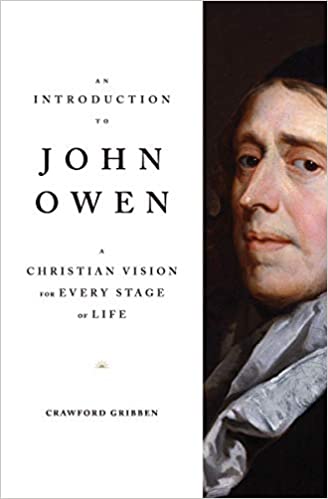A Book Review from Books At a Glance
By Gary Steward
Crawford Gribben, professor of early modern British history at Queen’s University Belfast, has published this short and valuable introduction to John Owen, following up on his masterful theological biography, John Owen and English Puritanism (Oxford, 2016). Gribben’s stated intention in this work is to organize and discuss Owen’s understanding of the ideal Christian experience of God’s grace as one progresses through the various stages of life: childhood, youth, middle age, death, and eternal life. In each of these chapters, however, Gribben deals heavily with Owen’s own life experiences, making connections along the way to the various stages of life that Christians go through.
Gribben opens his book with a twenty-page overview of Owen’s varied life—a life that stood at the very center of the theological and political events of seventeenth-century Britain. While Owen is widely known for his theological works, his writings are not often read in the light of his life and experiences in seventeenth-century Britain. Gribben’s opening introduction helpfully sets his eight million published words in their historical context and draws the reader into the broader world of Owen’s life and thought (43).
The first chapter, entitled “Childhood,” addresses Owen’s views on infant baptism and on the nurture of children in the Christian faith. In the discussion of these issues, Gribben references Owen’s Two Short Catechisms (1645) and his Primer (1652), a work which is not found in the twenty-four volume collection of Owen’s works published by the Banner of Truth Trust. In his discussion of Owen’s views on baptism, Gribben describes how Owen originally held that baptism takes away “our own inherent lust and pollution” (53). He came to view that baptism is a “sign and seal” of God’s grace after the Westminster Assembly completed its work and after he himself came into appreciative contact with prominent Baptist leaders in the early Commonwealth period. Regardless of his shifting positions on baptism, Owen was consistent in his belief that children ought to be nurtured and instructed in the faith, with the church and the family each having a role in spiritual instruction and in forming the minds and hearts of the next generation.
In his chapter on “Youth,” Gribben explores Owen’s instruction of young people, which grew out of his experiences in preaching and writing for undergraduate students while serving as the Vice Chancellor of Oxford University. Owen believed that youth need to be instructed to pursue an experiential knowledge of God. In this he was influenced by John Calvin but more significantly by Henry Scudder’s 1627 The Christian’s Daily Walk, which caused him to appreciate the role that the affections and everyday spiritual experience play in true Christianity. Owen caused controversy at Oxford for his 1651 sermons on communing with each person of the Godhead distinctly. After considering carefully the implications of this line of thinking for Trinitarian theology, Owen produced his 1657 Of Communion with God, which Gribben describes as “his greatest and most important and enduring contribution to evangelical literature” (83).
With the restoration of the Stuart monarchy in 1660, Owen’s life became one of significant challenges. In the chapter entitled “Middle Age,” Gribben addresses how Owen personally responded to disappointment and persecution, even while maintaining a quiet and consistent spirituality. Owen’s advocacy of religious toleration and congregationalism are the dominate topics in this chapter. Gribben argues that Owen’s political theory and arguments for religious toleration “made a very significant contribution to the emergence of the political tradition that has since been described as classical liberalism,” anticipating John Locke’s Two Treatises of Government by a few decades (100-101).
In his chapter on “Death and Eternal Life,” Gribben briefly explores Owen’s eschatology and his clear hope in eternally being with Christ that was evident toward the end of his life. Owen’s eschatology was somewhat vague through the course of his life, and he entered certain eschatological hopes during the Commonwealth period that were to be disappointed. Even so, Owen held clear views of the glory of Christ that was to be revealed to the saints upon their entry into eternal life.
Even though Gribben may have intended to write a work that gives Owen’s “Christian vision for every stage of life,” he sticks fairly consistently to Owen’s own life story throughout. As such, this work is more of a condensed theological biography than a description of the stages of life that Christians go through. While the actual work turns out to be somewhat different than how it is framed, Gribben has written a very helpful introduction to Owen’s life and a selection of his key works and theological themes. Gribben’s judgment is sound, and his appreciative perspective doesn’t descend into hagiography. The broad scope of the totality of Owen’s thought and writing deserves to be more broadly appreciated today, and this volume is a very helpful introduction for those who don’t have the resources or time to work through Gribben’s larger work.
Dr. Gary Steward
Assistant Professor of History
Colorado Christian University
